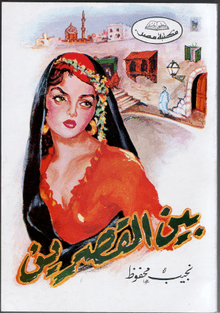Cairo Trilogy
 Cover of a recent edition of Palace Walk | |
| Author | Naguib Mahfouz |
|---|---|
| Original title | ثلاثية القاهرة |
The Cairo Trilogy (Arabic: الثلاثية (The Trilogy) or ثلاثية القاهرة (The Cairo Trilogy)) is a trilogy of novels written by the Egyptian novelist and Nobel Prize winner Naguib Mahfouz, and one of the prime works of his literary career.
The three novels are, in order:
- Palace Walk (original Arabic title: بين القصرين, Bayn al-Qasrayn, first Arabic publication 1956)
- Palace of Desire ( قصر الشوق, Qasr al-Shawq, 1957)
- Sugar Street ( السكرية, Al-Sukkariyya, 1957)
Titles
The three novels' Arabic titles are taken from the names of actual streets in Cairo, the city of Mahfouz's childhood and youth. The first novel, Bayn al-Qasrayn, is named after the medieval Cairo street in the Gamaliya district where the strict socially conservative protagonist, Ahmad 'Abd al-Jawad, and his family live. The second novel, Qasr al-Shawq, is named after the street where his eldest son Yasin and his family live, whereas the third, Al-Sukkariyya, is named after the street where his daughter Khadijah and her family live.
Narrative
The trilogy follows the life of the Cairene patriarch Al-Sayyid (Mr.) Ahmad 'Abd al-Jawad and his family across three generations, from 1919 – the year of Egyptian Revolution against the British colonizers ruling Egypt – to almost the end of the Second World War in 1944. The three novels represent three eras of Cairene socio-political life, a microcosm of early 20th century Egypt, through the life of one well-off Cairo merchant, his children and his grandchildren.
To Kamal, 'Abd al-Jawad's youngest son, Mahfouz admits that he gives him some features of himself, as they both have got a BA in philosophy from what is now the University of Cairo and have problems with profound contradictions they discern between religious principles and the scientific discoveries of the West.
Seen as a child in the first novel, a university student in the second, and a teacher, not married, in the third, Kamal loses his faith in religion, in love, and in traditions and lives in the second and third novels as an outsider in his own society. He keeps searching for meaning of his life until the last scene that seems an imposed one by Mahfouz to give some air of hope. Then Kamal's attitude to life changes to the positive as he starts to see himself as 'idealistic' teacher, future husband and revolutionary man.
Likewise Mahfouz sees the development of society has an important influence on the role of women, so he represents the traditional, obedient women who do not go to school such as Amina, 'Abd al-Jawad's wife, and her daughters in the first novel, women as students in the university such as Aida, Kamal's beloved, in the second novel, and women as students in the university, members of the Marxist party and editors of the journal of the party in the third novel.
Throughout the trilogy, Mahfouz beautifully develops his theme: social progress will be the inevitable result of the evolutionary spirit of humankind. Time is the major leitmotif in all three books, and its passage is marked in myriad literal and symbolic ways, from the daily pounding of bread dough in the morning, which serves as an alarm clock for the family, to the hourly calls for prayers that ring out from the minarets of Cairo. In the first novel time moves slowly, and we sense that because this story belongs to Kamal, still a child, time should indeed feel like a mastodon lumbering slowly through an enchanted landscape; the permanence of childhood is pronounced, and the minutes often tick by like hours. And yet inevitable changes occur: sisters get married, babies are born, grandparents die, life goes on. The passage of time quickens in the following book, and doubles yet again in the third. By the time the trilogy concludes whole years seem to fly by to the middle-aged Kamal, and a reader can only join him in shaking her head at the wonder and mystery of it all.
Mahfouz' concern with the nature of time was no accident, as he had studied the French Philosopher Henri Bergson as an undergraduate, and was also deeply impressed by Proust's Remembrance of Things Past, Proust being another of Bergson's admirers. According to Bergson's philosophy, one needs to make a distinction between psychological time and real, physical time; psychological time is apprehended through intuition, whereas real time is apprehended through the intellect. "Supreme" moments in time Bergson called Duration, and these are the moments when we really live. In the Cairo Trilogy Mahfouz incorporates this idea both frequently and masterfully, dramatizing Bergson's philosophical theories on the nature of time and evoking the most fundamental of human concerns: why are we here?
Translations
The Cairo Trilogy was first translated into Hebrew between 1981 and 1987. Mahfouz was very satisfied by this and saw it as another proof that the Israeli-Egyptian peace treaty of 1979 should be supported. The English translation was published by Doubleday in the early 1990s. The translators were:
- Palace Walk - William M. Hutchins and Olive Kenny
- Palace of Desire - Hutchins, Olive Kenny and Lorne Kenny
- Sugar Street - Hutchins, Olive Kenny and Angele Botros Samaan
The translation was overseen by Jacqueline Kennedy Onassis, an editor at Doubleday at the time, and Martha Levin.[1]